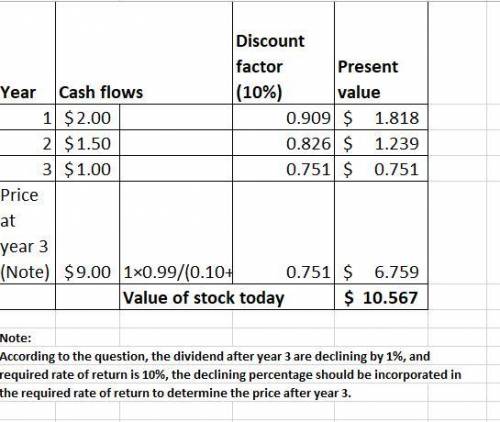
Business, 10.03.2020 07:55 garrettrhoad
Mature Products Corporation produces goods that are very mature in their product life cycles. Mature Products Corporation is expected to pay a dividend in year 1 of $2.00, a dividend of $1.50 in year 2, and a dividend of $1.00 in year 3. After year 3, dividends are expected to decline at a rate of 1% per year. An appropriate required rate of return for the stock is 10%. The stock should be worth

Answers: 1


Another question on Business

Business, 21.06.2019 21:00
12. nelson corporation, which has only one product, has provided the following data concerning its most recent month of operations: selling price $ 115 units in beginning inventory 380 units produced 5,900 units sold 6,070 units in ending inventory 210 variable costs per unit: direct materials $ 46 direct labor $ 27 variable manufacturing overhead $ 3 variable selling and administrative $ 12 fixed costs: fixed manufacturing overhead $ 112,100 fixed selling and administrative $ 36,420 the company produces the same number of units every month, although the sales in units vary from month to month. the company's variable costs per unit and total fixed costs have been constant from month to month. a. prepare a contribution format income statement for the month using variable costing. unit product cost under variable costing direct materials direct labor variable manufacturing overhead variable costing unit product cost (formula)
Answers: 3

Business, 22.06.2019 01:00
Bond x is noncallable and has 20 years to maturity, a 7% annual coupon, and a $1,000 par value. your required return on bond x is 10%; if you buy it, you plan to hold it for 5 years. you (and the market) have expectations that in 5 years, the yield to maturity on a 15-year bond with similar risk will be 9.5%. how much should you be willing to pay for bond x today? (hint: you will need to know how much the bond will be worth at the end of 5 years.) do not round intermediate calculations. round your answer to the nearest cent.
Answers: 3

Business, 22.06.2019 07:30
Suppose a firm faces a fixed price of output, 푝푝= 1200. the firm hires workers from a union at a daily wage, 푤푤, to produce output according to the production function 푞푞= 2퐸퐸12. there are 225 workers in the union. any union worker who does not work for this firm is guaranteed to find nonunion employment at a wage of $96 per day. a.what is the firm’s labor demand function? b.if the firm is allowed to choose 푤푤, but then the union decides how many workers to provide (up to 225) at that wage, what wage will the firm set? how many workers will the union provide? what is the firm’s output and profit? what is the total income of the 225 union workers? c.now suppose that the union sets the wage, but the firm decides how many workers to hire at that wage (up to 225). what wage will the union set to maximize the total income of all 225 workers? how many workers will the firm hire? what is the firm’s output and profit? what is the total income of the 225 union workers? [hint: to maximize total income of union, take the first order condition with respect to w and set equal to 0.]
Answers: 3

Business, 22.06.2019 14:00
Which of the following would not generally be a motive for a firm to hold inventories? a. to decouple or separate parts of the production process b. to provide a stock of goods that will provide a selection for customers c. to take advantage of quantity discounts d. to minimize holding costs e. all of the above are functions of inventory.
Answers: 1
You know the right answer?
Mature Products Corporation produces goods that are very mature in their product life cycles. Mature...
Questions



Mathematics, 07.05.2021 16:20

Mathematics, 07.05.2021 16:20




Mathematics, 07.05.2021 16:20

Mathematics, 07.05.2021 16:20


English, 07.05.2021 16:20

Mathematics, 07.05.2021 16:20



Mathematics, 07.05.2021 16:20

Mathematics, 07.05.2021 16:20


Mathematics, 07.05.2021 16:20


Mathematics, 07.05.2021 16:20




